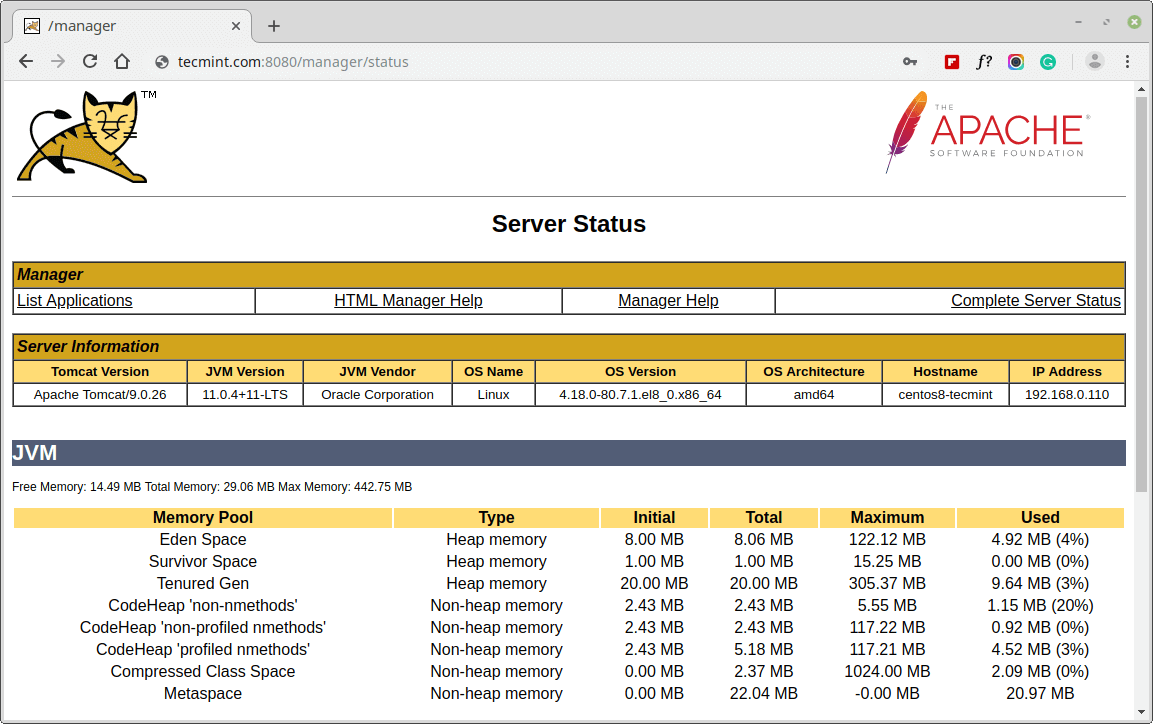

Using Tomcat ManagerĪlthough it is a lightweight application, you can access Manager's functionality in three different ways:
#Tomcat 8 manager url update
Simply rename "manager.xml" to a name of your choice, create a new directory with the same name, and then update Manager's docBase attribute with the new name. Add the following entry, with the allowed IP address set to an appropriate value (or values, separated by commas):Īlternatively, if you prefer to control access by hostname rather than IP address, use a Remote Host Valve instead:įinally, you can rename and relocate the Manager application itself in order to protect your server from automated attacks that search for it in its default location. You can do this by nesting a Remote Address Valve within Manager's Context element, found in the file "$CATALINA_HOME/webapps/host-manager/manager.xml". Next, you should restrict access to Manager to only the IPs that will need to access it. You can force Tomcat to send authentication data over Tomcat SSL instead by adding a user data security constraint to Manager's "/WEB-INF/web.xml". Making the Manager program secure is a matter of improving the security of its communication with the user, and restricting all unnecessary access points.īy default, logins to Manager occur in plain-text. Before we get down to using Manager, though, let's take a few minutes to eliminate the potential security risks of enabling this program. That's it! If you've configured everything correctly, the users you specified should now have access to the Manager application. This user entry can either be located in the default "tomcat-users.xml" file, located in "$CATALINA_BASE/conf/", or in your JDBC or JNDI Realm, depending on your server configuration.
#Tomcat 8 manager url password
To start experimenting with Manager, you'll need to either add the "manager" role to an existing user entry's list of roles, or create a new username and password specifically for accessing Manager. Tomcat makes sure that not just anyone can access the Manager program by only allowing users with the role "manager" to utilize the program.

Sound good? Great - we'll start by configuring Tomcat to allow us access to the Manager program, so that we can dig in and see what it can do. This article also goes over some best practices you can follow to make sure that Manager isn't used maliciously - whether you end up using it or not. Still, it pays to know about any administrative processes running on your server. Although Manager starts automatically by default, it takes some additional configuration to allow anyone access to it. The other reason you should spend some time learning about Manager is that as an administrative program enabled in Tomcat by default, it represents something of a Tomcat security concern.ĭon't worry - Apache hasn't built a back door into your server. Later in this article, we'll get Manager up and running, and go over some situations where each of the three ways you can access its functionality could come in handy. Though lightweight, there's actually a lot of functionality packed into this little application, and when used in conjunction with Apache Ant for task automation, it can really come in handy. Is your organization using Tomcat? Tcat's central management console provides key enterprise features not offered by Manager, such as application provisioning, deep real-time diagnostics, configuration profiles, and reliable restarts for your entire Tomcat infrastructure.įirst of all, as of Tomcat 6.x, which did away with the "admintool" that was included in version of Tomcat up to 5.5.x, Manager is the only "out-of-the-box" administrative tool included with Tomcat, so it's worth checking out. If you are using Tomcat in an enterprise environment, you may not end up spending too much time with it, but there are a few reasons why you should at least be aware of it and have a general grasp of its functionality. All standard distributions of Apache Tomcat 4.1.x and following include a web application called Manager, a lightweight monitoring and administration tool with the ability to deploy, undeploy, and reload applications without shutting down the Container.


 0 kommentar(er)
0 kommentar(er)
